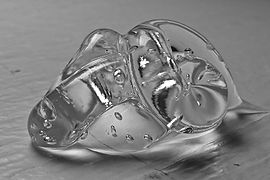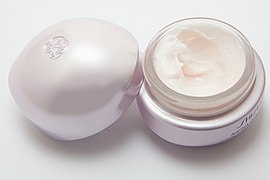Rivka Fidel
Upon completing this chapter, you should be able to:
- Define colloid
- Explain the difference between colloids, clays and phyllosilicates
As discussed in the Importance of Soil Chemical Properties chapter, soil surfaces serve a very important role as the interface between solid particles and other parts of the soil: water, solutes, and gases. Due to its interactions with water and solutes therein, surfaces are also referred to as the solid-solution interface.
Recall that as particle size decreases, surface area increases. Therefore, the smallest particles, clay-sized (2 µm) and smaller, have the greatest influence on soil surface area and soil surface properties. Even smaller than clays, at <1 µm, colloids have an even greater influence on surface area and therefore soil surface properties. Unlike clays, colloids are any particle (or liquid droplet) less than 1 µm in diameter. Colloids can be organic or inorganic, and liquid or solid. Even water droplets in clouds and mist are considered colloids! In soil, the colloidal fraction refers to all solid particles less than 1 µm in diameter.
Below are examples of natural and man-made colloids, according to their phases. For example, smoke has a solid dispersed phase and a gas dispersion medium because smoke is solid particles suspended in air, formed during combustion.
| Gas (Dispersed phase) |
Liquid (Dispersed phase) | Solid (Dispersed phase) | |
| Gas (Dispersion medium) | No such colloids are known. Helium and xenon are known to be immiscible under certain conditions. | Liquid aerosol
Examples: fog, clouds, condensation, mist, steam, hair sprays |
Solid aerosol
Examples: smoke, ice cloud, atmospheric particulate matter |
| Liquid (Dispersion medium) |
Foam
Example: whipped cream, shaving cream |
Emulsion or Liquid crystal
Examples: milk, mayonnaise, hand cream, latex, biological membranes, liquid biomolecular condensate |
Sol
Examples: pigmented ink, sediment suspended in water, precipitates, solid biomolecular condensate |
| Solid (Dispersion medium) |
Solid foam
Examples: aerogel, floating soap, styrofoam, pumice |
Gel
Examples: agar, gelatin, jelly, gel-like biomolecular condensate |
Solid sol
Example: cranberry glass |
Below are some examples of colloids:
|
Aerogels have colloid-sized bubbles dispersed in a solid medium. This is what makes them so lightweight and great for space missions.
|
Jell-O cubes have colloid-sized water droplets embedded in a solid matrix.
|
Colloidal silica gel with light opalescence. Silica gels have gas embedded in a solid silica matrix.
|
Whipped cream has colloid-sized gases in a liquid medium, where liquid is cream.
|
|
|
Hair gel is made of a network of particles in a fluid medium.
|
Creams are semi-solid emulsions of oil and water.
|
Mist is a colloid-sized water suspended in air (i.e. a liquid colloid in a gas).
|
||
[Adapted from Wikipedia, CC BY-SA]
Understanding the chemistry of colloids and their surfaces allows us to predict what chemicals – including nutrients and toxins – the soil can retain. Different types of soil colloids have different surface properties. The two main categories of soil particle types are inorganic and organic. The main categories of clay to colloid-sized inorganic particles, aka minerals, are: crystalline silicate clays (phyllosilicates), quasi-crystalline silicates, and oxides and hydroxides (mainly of iron and aluminum). The organic colloids form their own category. So, all in all there are 4 categories of colloids in soil:
- Crystalline silicate clays (phyllosilicates): layered minerals containing SiO4
- Poorly crystalline silicates: sphere and tube-shaped minerals containing SiO4
- Oxides and hydroxides: highly weathered minerals containing O2-, OH–, and OOH3-, bonded to transition and post-transition metals (mainly Fe and Al)
- Organic colloids: particles of biological origin <1 μm in size that contain C-H and/or C-C bonds, also called “colloidal humus”
In the upcoming chapters, we’ll discuss each colloid type in detail.
- Colloids are particles less than 1 micrometer in diameter
- There are 4 types of colloids in soil:
- Crystalline silicates clays, aka phyllosilicates or “layer clays”
- Poorly crystalline silicate minerals
- Aluminum and iron oxides and hydroxides
- Organic colloids, also called colloidal humus










